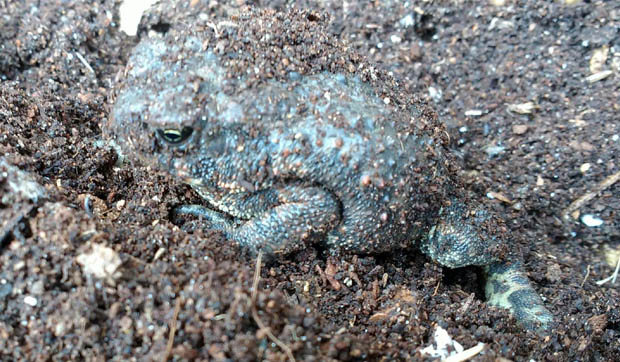American toads typically spend the winter burrowed deep in the soil. This one, for better or worse, chose to dig into a compost pile.
Good Natured: Toads in Winter
November 16, 2018
We’ve all been there at one time or another: That awkward moment when you realize you’ve accidentally woken someone.
Perhaps it was a phone call at an inopportune time. Or an unintended bump during an airline flight.
Or, maybe, you hit them with a shovel.
That’s the predicament I found myself in last week as I worked to relocate the Hickory Knolls compost pile. It had grown considerably over the summer and our goal was to transfer it into buckets and get it moved to the garden plots before it froze solid.
I was scooping at a pretty brisk pace, for though the sun was shining at the time, snow was predicted the next day. All in all, the project was going along pretty smoothly, save for the times I’d have to stop and remove landscape rocks that had incorporated into the heap.
Sometimes the rocks would clank against the shovel head, and sometimes not. Either way, I was doing my best to make sure they stayed separate from the compost and, as I tend to do, started organizing them in my mind as I tossed them aside.
“Basalt.”
“Schist, hehee.” (Sorry, but that name always makes me laugh.)
“Gneiss”
“Toad.”
Say whaaa…??? I did a doubletake as my shoveling screeched to a halt. But sure enough, tucked against a lump of unidentifiable organic matter, sat Anaxyrus americanus, an American toad.
The little guy (gal?) was scrunched down with eyes closed, its forelimbs tucked under its chin. Most notable though was its color, a striking blue gray unlike anything I’ve ever seen on a living, breathing toad.
What happened next was that awkward moment I mentioned earlier. The toad, which had clearly been in some sort of hibernative state, shrugged, wiped its face with its front foot and slowly-ever so slowly-opened an eye.
At first I wasn’t exactly sure what to do. An apology seemed so inadequate, given that I may have just jeopardized the little amphibian’s chances for survival. Plus there was a whale of a language barrier. But apologize I did, profusely, even as I decided to go for broke and take a photo too, before gently placing the toad as close to where I found it as I could.
From that point on, the compost relocation project effectively ceased. I raked the remaining debris toward and on top of the spot where the toad lie embedded, aiming to approximate the depth to which it had buried itself. I then laid some sticks to serve as markers as well as reminders to not stack anything on top of or move the rest of the pile until spring.
You’d think that would be the end of the story. But no, I’m afraid it’s only the beginning. Because now the waiting begins. So too, soft-hearted sap that I am, does the worrying. Will the toad be okay?
See, here’s the thing. In our area, toads survive cold temperatures by burrowing down below the frost line, a depth of around 30 in. or so. Yet the spot at which I found the compost toad was nowhere near that deep. I’d say 12 inches, tops. Did the toad really think 1 foot would be enough?
Judging by its size, I’d say this winter is not its first. So it does have some proven survival instincts. But was it fooled by the soft compost, which initially made for easy digging? Had it intended to dig deeper, but was thwarted by the layer of landscape rocks upon which the compost sat? Was it caught unawares by the early cold snap?
I also can’t help but wonder, do overwintering toads always turn blue?
Part of me wants to head back out, dig up the toad and bring it inside, then spend the winter spoiling it with plump crickets and other toad-ally delectable fare. My way of making amends, so to speak.
But that’s not the way nature works, nor is it the way naturalists work. Instead I’ll plan to write a follow-up column next spring, and in the meantime busy myself by doing more toad research, delving deeper into toad biology, toad ecology and toad physiology. All the while, of course, letting sleeping toads lie.
Pam Otto is the manager of nature programs and interpretive services at the Hickory Knolls Discovery Center, a facility of the St. Charles Park District. She can be reached at 630-513-4346 or potto@stcparks.org.

